
 HMS WESTCOTT
HMS WESTCOTT Click on the links within this brief
outline for first hand accounts by the men who served on HMS Westcott and for a more detailed chronolgy
see www.naval-history.net
Commanding Officers
| Lt
Cdr C R Peploe (1918 – )* Lt Cdr A B D James (1930 – )* Cpt Lolly (1936 – )* Cdr Firth (1938 – ) * Cdr James Alexander Corrie-Hill, RN (Sep 1938 – Sep 1939 or Feb 1940) |
Lt Cdr William Francis Rodrick Segrave, RN (Sep
1939 or Feb 1940 – Feb 1941) Cdr. Ian Hamilton Bockett-Pugh, RN (Feb 1941 - Feb 1943) Lt Cdr Hedworth Lambton, RN (May 1943 – Jun 1944) Lt Cdr Edward Perry Reade, RN (Oct 1944 – Jun 1945) Lt J S de B. Smith (Jun 1945 - |
Officers
Further
names from the
Navy List will be added later.
| Lt.
C P d’A Aplin, RNR (Dec 1940 - Lt. F C V Brightman (Aug 1938 - Tempy. Lt. N D Britton RNVR (Oct 1943 - Gunner C W Chadwick (Apr 1939 - S.Lt. S B de Courcy-Iceland RN (1918 – 1919) Tempy. Surg. Lt. P U Creighton, MB, BCh, RNVR (Oct 1944 - Gunner (T) M Daniels (May 41- Lt.(E) R J H Duffay, MBE (Jul 1938 - Boatswain D H Easter (May 1940 - Lt. J N Elliott (Apr 1940 - Lt. S W M Farquharson-Roberts RN (Jun 1943 - Lt Arthur Lewis Gulvin RN (Feb - April 1940) Tempy. Lt. W J C Higgs, RNVR (Oct 1944 - Tempy. S.Lt. N J Hill, RNVR (Jun 1945 Lt. G R D Holland (May 1941 - Mid. L T H Johnson RNR (Aug 39 - Lt David Charles Kinloch RN (July 1930 - Jan 1932) Tempy. Gunner F B Leathers (Apr 1943 - Tempy. Surg. Lt. J D Loughborough, MRCS, LRCP, RNVR (Jun 1943 - Tempy. Surg. Lt. J D Manning, MRCS, LRCP, RNVR (Jul 1941- |
Tempy. Lt. A R A Marshall, RNVR (Jun 1943 - Gunner (T) S T Newman (act) May 1945 - Tempy. Act. S.Lt. A G C M Nightingale, RNVR (May 1941 - Lt Denzil Richard Cranley Onslow RNR (Nov 1942) Lt. C A H Owen (Aug 1937 - Lt. A Parsons, RNVR (Oct 1944 - Tempy. Act. S.Lt. W B Potts, RNVR (Apr 1944 Tempy Lt.(E) G R Raeburn, RNR (Jan 1944 - Tempy. S.Lt. W A Reeve, RCNVR (Dec 1943 Tempy. Lt. T S Riches, RNVR (Jun 1943 - Gunner J F Sangwell (Apr 1937 - Tempy. Surg. Lt. R Scott, MB, BS, RNVR (Jun 1940 - July 1941) Lt. J S de B. Smith (Jan 1945 - Tempy. Wt. Eng. A F Stapleton (Dec 1940 - Gnr Walter James Taylor RN (Sept 1936 - Feb 1937) Lt. N J M Teacher (Feb 1939 - Lt. A G Vanrenen (Dec 1941 - Lt Cdr Arthur Oliver Watson RN (Sept 1934 - July 1935) Tempy. S.Lt. J C Whitehead, RNVR (May 1945 - Lt. (N) W Whitworth (Apr 1937 - |
HARD LYING
Conditions on V & W Class destroyers were so bad in rough weather that the men who served on them were paid hard-lying money. These stories by veterans who served on HMS Woolston were published in Hard Lying, the magazine of the V & W Destroyer Association and republished in 2005 by the Chairman of the Association, Clifford ("Stormy") Fairweather, in the book of the same name which is now out of print. They are reproduced here by kind permission of Clifford Fairweather and his publisher, Avalon Associates. Copyright remains with the authors and photographers who are credited where known.They are reproduced here by kind permission of Clifford Fairweather and his publisher, Avalon Associates. Copyright remains with the authors and photographers who are credited where known.
Stormy Fairweather tells his own story below and in a recorded interview made at the reunion of the V & W Destroyer Association at Warwick on the 20 April 2013.
A 'Bunting Tosser' in HMS Westcott tells his Story
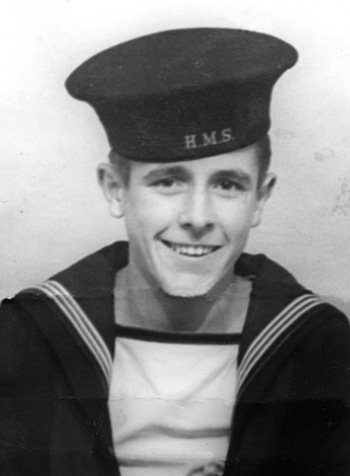 It was early January 1944, after
initial training at 'Royal Arthur at Skegness and signals training at
'Scotia' at Ayr. I found myself on a draft from Chatham to HMS Westcott
who was at the time berthed at Greenock. I arrived at Glasgow railway
station after a long and tedious journey. There were three others on
the same draft. When we reported our arrival, we were told that
transport down to the docks would not be available for at least an
hour, so to lose ourselves, we did not need a second telling so we
adjourned to the nearest watering hole where I was introduce to my
first 'Black and tan'. The most I had drank until then was the
occasional 'Brown Ale'. After three pints of this nectar we were called
to our transport, one of the Naval trucks. By the time we arrived at
Greenock I was a little worse for wear. However, somehow, I still don't
know how, I managed to negotiate two gang planks and landed on the deck
of HMS Westcott. I was
directed to what was to be my mess, down a hatchway to the mess deck.
It was early January 1944, after
initial training at 'Royal Arthur at Skegness and signals training at
'Scotia' at Ayr. I found myself on a draft from Chatham to HMS Westcott
who was at the time berthed at Greenock. I arrived at Glasgow railway
station after a long and tedious journey. There were three others on
the same draft. When we reported our arrival, we were told that
transport down to the docks would not be available for at least an
hour, so to lose ourselves, we did not need a second telling so we
adjourned to the nearest watering hole where I was introduce to my
first 'Black and tan'. The most I had drank until then was the
occasional 'Brown Ale'. After three pints of this nectar we were called
to our transport, one of the Naval trucks. By the time we arrived at
Greenock I was a little worse for wear. However, somehow, I still don't
know how, I managed to negotiate two gang planks and landed on the deck
of HMS Westcott. I was
directed to what was to be my mess, down a hatchway to the mess deck. 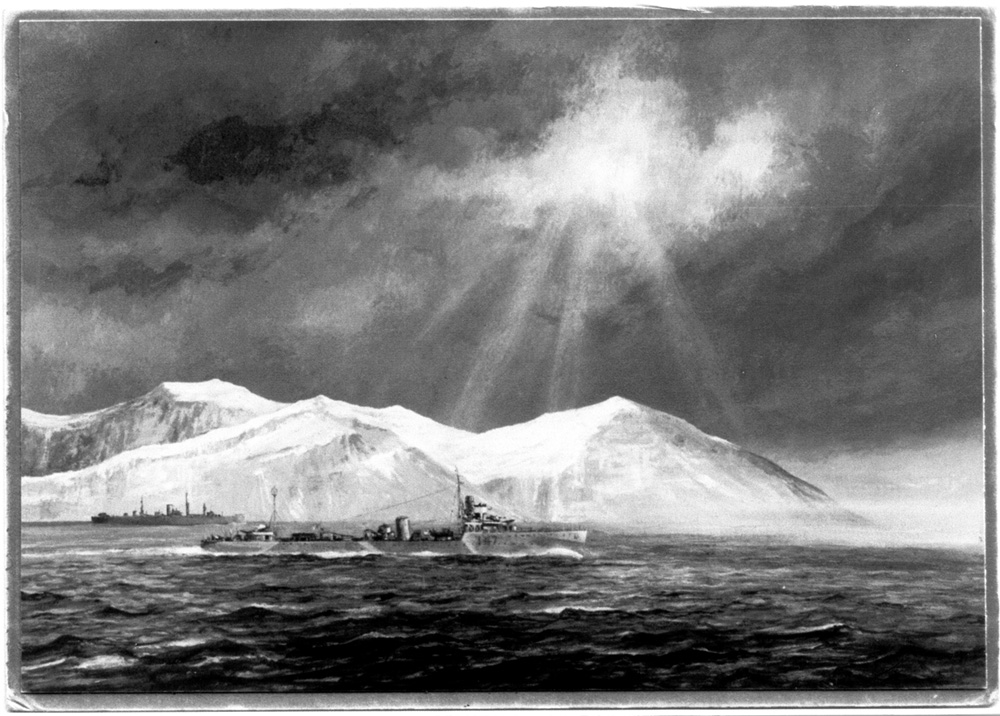
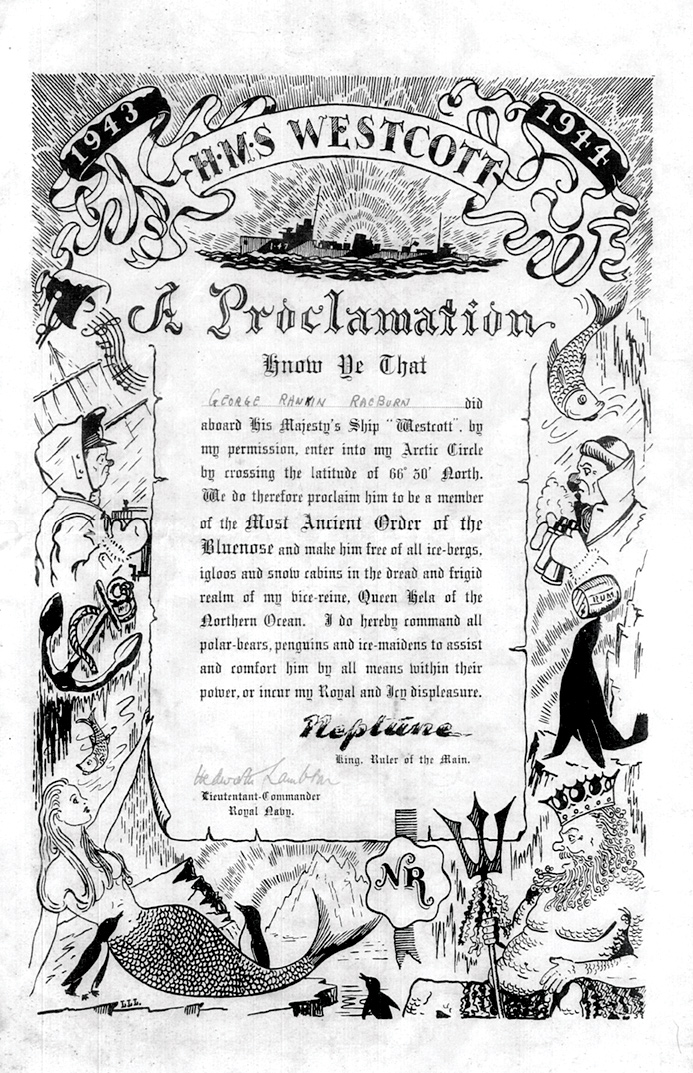
Bill Forster recorded an interview with
Clifford ("Stormy") Fairweather at Warwick on the 20 April 2013
You can click on the link to listen to "Stormy" describe his wartime service on HMS
Westcott
be patient - it takes a couple of
minutes before the file opens and Clifford starts speaking
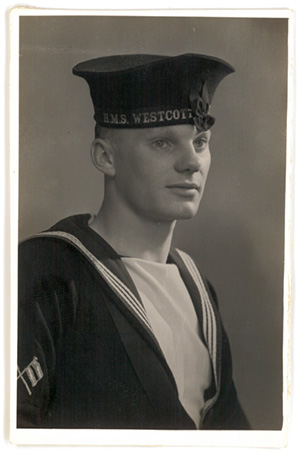
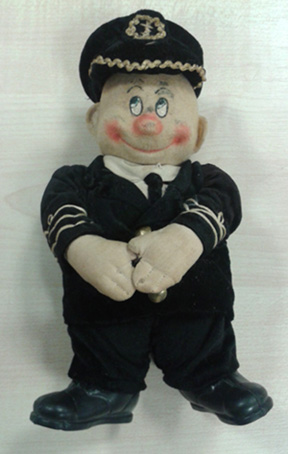 My
father died in 2009 and never said much about his war and my own
memories are fading now. I believe he was proud of his involvement and
joining HMS Westcott, his
first ship, at nineteen changed his life, and not always for the best.
His fondest memories were of his time on HMS Westcott because of the sense of
comradeship he felt but he went on to serve on HMS Helvig, a mine-layer (or floating
bomb as he called it).
My
father died in 2009 and never said much about his war and my own
memories are fading now. I believe he was proud of his involvement and
joining HMS Westcott, his
first ship, at nineteen changed his life, and not always for the best.
His fondest memories were of his time on HMS Westcott because of the sense of
comradeship he felt but he went on to serve on HMS Helvig, a mine-layer (or floating
bomb as he called it).
On that day I was a 21 year old Lieutenant, one of three bridge watch
keepers in HMS WESTCOTT, a WWI destroyer, escorting the homeward bound
convoy RA.55A, roughly south of Bear Island. I had the middle watch, so
Christmas started for me at 0001 on the bridge. Course west, wind south
west rising to gale force, plenty of icy spray. We spent much of the
time finding four fleet destroyers, lent for protection, but to pass
them the message that they were now required to join the eastbound
convoy JW55B which had recently passed us.
My next watch was the afternoon, so Christmas lunch had to be taken
alone in the wardroom at around 1130. Our course was now northwest
towards the pack ice, presumably to distance us from trouble -
intelligence reporting that the mighty battlecruiser SCHARNHORST was
stirring and might be sailing north. The wind was now gale force and on
our port beam, strong enough to roll us 45 to 50 degrees to starboard.
To stop everything flying about, the wardroom staff secured the settee
and the two arm chairs hard up against the starboard wall settee, thus
making a comfortable channel in which to sit with lunch on one's lap,
without fear of the meal taking flight. Despite the turmoil the steward
produced delightful roast beef and a wonderful roast potato - why
"wonderful"? Because we only had upper deck stowage for vegetables, so
after three days out from our Russian port anything not eaten would be
frost bitten and ditched. The wardroom cook [bless him!] kept enough
spuds below to give us all one for Christmas. Otherwise it would have
been rice balls - edible but not quite the same. Next came the usual
figgy duff, nice enough!
Soon it was time for my duffel coat, oilskin and neck towel - at all
costs keep the icy spray off your chest! - and now the very careful
opening of the starboard watertight door to the upper deck. This has
five steel clips, one above and below, three down the side, the middle
where a handle would normally be. This one you leave to last, and seize
the moment when returning from the big starboard roll to get out. You
now have a few seconds in which to close all five clips, get round
forward of your superstructure where you reach a long, high, taut
jackstay reaching to the break of the forecastle. From it hang strips
of rope called lizards, with hard eyes so they can travel along the
jackstay. You grab one and start walking along the iron deck - V&W
destroyers have no passage below. Once or twice progress will be
interrupted when the big roll lets seawater foam across the deck -
"shipping it green", as they say. This can dislodge your seaboots'
slippery grip, but as long as you keep hugging that lizard you will
soon get going again. At least you can see things; midday in midwinter
at those latitudes gives you a dim dawn slowly turning into a similar
dusk, with about 21 hours of darkness ahead. Arriving at the forecastle
you change grip with care to a metal rung ladder - gloves essential,
the icy rungs would take strips off your bare hands - and after three
such ladders you are back on your open bridge.
Christmas afternoon brought the news that the SCHARNHORST and escorting
destroyers were at sea, probably after the laden outward convoy JW.55B,
that three of our cruisers were joining its defence. One was BELFAST,
still alongside at London. The Home Fleet was steaming east at top
speed to join the fray. In RA.55A
we were fast leaving the scene but could follow the Boxing Day ensuing
battle by radio, since Admiral Frazer in the battleship DUKE OF YORk
decided to use plain language for signals for greater speed of action.
As the gallant SCHARNHORST finally went down fighting there was
rejoicing, but 70 years on one remembers that only 36 survivors were
picked up from 1,767 men. Men probably very similar to us, and often
with a common enemy, the sea.
Lt. Stuart W M Farquharson-Roberts RN
During the 1930s unemployment was a great problem, good jobs were
scarce. I was fortunate in having a job, but with strings attached.
Located 60 miles away from home in Plymouth, it offered little in the
way of prospects. A case of waiting for 'dead mans shoes'. Financially
it was hopeless, after paying for digs and the fare home at the
weekends, I was broke. Eventually with the consent of my parents I
resigned so as to return to Plymouth to seek work locally.
After several unsuccessful interviews my morale was at a low ebb. A
family friend suggested that I might consider joining the Navy as a
writer, it offered job security and, of course at the end there was a
pension to be had. In those days a job with a pension was looked upon
with envy.
From enquiries I learnt that entry into the Writers branch of the R.N.
was by open competition held twice yearly, with an intake of about
thirty. With my future uncertain, I decided to go ahead and try to join
up. Following my success at the 1935 examination, I was
granted my choice of Port Division - Devonport and joined HMS Drake in
November as a new entry. Training was a combination of square bashing
and technical instruction and was completed without incident. I was
rated Writer and assigned to HMS Drake as a supernumerary.
A few months later with my official number hardly dry I received a
draft chit to join HMS Medway on the China station with passage as far
as Singapore on the V&W class destroyer Westcott.
Initially it was an unsettling experience, particularly bearing in mind
the distance involved and the period away would be at least two and a
half years. Air mail had not yet started which meant a letter would
take about six weeks to reach Hong Kong. The formalities of
a foreign draft being completed the days began to slip by and it wasn't
long before that on a cold blustery November morning with my
kit-bag and hammock I reported on board HMS Westcott. My first
impression was unforgettable, a mixture of super heated steam, hot
metal and the sounds of auxiliary machinery. My adventure was about to
begin! Most of the forenoon was occupied in settling in,
stowing away my gear etc; The seaman's mess would be my
home for the duration of the voyage, located in the fore part of the
ship, by any standards it was spartan. In the centre of the mess was a
steam engine used to drive the capstan, when the contraption was in use
the whole mess was enveloped in steam. Time is running out.
Tomorrow we leave these shores bound for the Far East and it's many
mysteries. Time for last farewells. The ships company offered theirs
some days earlier, being Chatham Division they had very few connections
with the West country. Weather conditions throughout the
night deteriorated, by daybreak the wind had reached gale force and was
still rising. Many vessels were running for shelter. A grim prospect
for us. With final preparations complete, securing lines
were cast off, the ship severed her link with the Devon shore and into
headed into Plymouth Sound, passing the mile long breakwater with it's
familiar lighthouse before entering the English Channel only to
encounter more severe weather, in fact, a 'No Go' area for an elderly
destroyer of just 1100 tons. Suddenly it happened, the ship turned
about and headed back to Plymouth, eventually making secure to the duty
destroyer buoy off Drakes Island. There we remained throughout the day,
come late afternoon there was a 'buzz', shore leave? Needless to say it
never materialised, for me as a 'sprog' it was a disappointment,
especially living in the locality. There was still a great deal to
learn about the Navy, particularly the need to take 'buzzes' with a
pinch of salt.
This voyage could be described as my introduction to Blue Water, I was
quite unprepared for such an experience that lay ahead. Racing 14ft
dinghies in Plymouth Sound offered little by way of preparation for
such a lengthy ocean passage. At about 11pm there occurred much
activity, the ship was being made ready for sea despite the
weather which showed no sign of improvement. It seemed that the
Commanding Officer, a Lieutenant Commander R.N. was faced with a thorny
problem and the ball was squarely in his court. He could either wait
for an improvement in the weather which would entail falling behind
with his schedule as a result or set off now.
How could he possibly maintain a schedule under these conditions? He
decided to slip and proceed. Leaving the shelter of Plymouth the motion
of the ship became increasingly violent, it was evident that we were in
for a trying night with the sound of the wind and the terrible pounding
from the sea, it was unnerving to put it mildly. Then suddenly it
happened, I collapsed being seasick violently and repeatedly. I really
did not care whether we did a vertical take off or plunged straight to
the bottom. I was not the only one, but the other victims seemed to be
at a lesser degree than I, but they were destroyer men and used to this
sort of situation. I take my hat of to them, one and all.
Had I been left to my own devices I may well have been swept over the
side. It was the Coxswain who put things right, patching me up and
twenty four hours later I was up and almost ready to make myself
useful. Never again was I to suffer from sea sickness despite going on
to serve in a variety of ships from Aircraft carriers to
Frigates.
Almost a week later we came alongside at Gibraltar where our stay was
extended to repair the storm damage. This would be a lengthy itinerary
which would offer countless opportunities for exploration of the
'Rock'. My first impression was its size, relatively small
with an area of about two and a half miles on the south coast of Spain,
commanding the North side of the Atlantic entrance to the Mediterranean
Sea which makes it important strategically. The main town at the North
western corner appeared to consist of a main street occupied by a
number of bars, there seemed to be three types, some had an orchestra,
others were a type of 'Bistro' bar, a drink that was popular at the
time was 'Coffee Royal'. This visit offered the perfect beginning to a
foreign commission, the easy stages in transit into a working ship
broke one in gradually. At journey's end one felt less of being a fresh
arrival on a foreign station. With repairs complete it was time to
press on to Malta, our next port of call, it was an uneventful leg of
the journey although useful in providing opportunities to increase the
efficiency of the ship’s company.
Upon arrival at Malta we did not rate very highly in the pecking order,
instead of the convenience of going alongside it meant tying up to one
of the many buoys. When shore leave was granted it meant going ashore
in what can only be described as a cross between a gondola and a canoe
called Dhaiso? The capital city, Valetta had much on offer to interest
new arrivals, the other principal centre being Sliema. Familiar sights
and sounds recalled are the milk vendor with his flock of goats, his
cry "Aleep, eggs, bread", the "Egyptian Queen" and the "Lucky
Wheel".
Leaving Malta in our wake we are now bound for Port Said. Since
clearing Malta it has become warmer, the sun reflecting off the surface
of Mediterranean with the sparkle of a million diamonds. The rig of the
day was changed to tropical in keeping with this type of
weather.
From now on more time must be allowed for washing clothes during dog
watches. The routine is simple, get hold of a spare bucket and a bar of
'Pussers' soap and you are on your way. I soon became a dab hand at
it. The time I spent in a seaman's mess as a junior rating
was priceless. I was taught how to prepare a meal for the mess, take it
to the galley, and fetch it when it was cooked. To keep the living
space clean and tidy, and above all, to show consideration to others.
These lessons I have never forgot and they stood me in good stead
throughout my life. The stay at Port Said was a short one.
I could not fail to be impressed by the statue in memory of Ferdinand
de Lesseps, the builder of the 101 mile long Suez Canal which was
opened in 1869 linking the Mediterranean and the Red Seas through which
we were shortly to make our way. Also worthy of mention were the twin
columns of the 1914-1918 War Memorial. The following incident remains
undimmed in my minds eye, but as the years pass I can see the funny
side of it. The ship was secured close inshore, it was during the early
part of the forenoon. A party of official types came on board, it
turned out that they were local Port Health Officials who had come to
carry out a medical inspection of the ship's company. All junior
ratings were summoned to fall in on the quarter deck, step up to the
official, drop your shorts and allow the said official, with the aid of
a large and powerful torch, to carry out the inspection, all this in
full view of the interested locals on shore.
Entering the Red Sea, change was evident, Western influence gave way to
the Eastern, particularly among the craft at sea, mostly sailing
vessels. The weather varied from cloudy to bright sunshine with rough
seas, nothing that I could not cope with. It was now that my request to
take a turn at the wheel was granted. I was elated, it isn't everyone
that could say that they had taken the wheel of a Royal Naval
Destroyer, especially a young writer.
Passing through Hells Gates we crossed the Arabian Sea to arrive at our
next destination Karachi, where much in the way of hospitality was
received. One incident still unforgotten was the street entertainer
with his act "Snake fight Mongoose 4 anna's.”
Then it was on to Penang where Christmas was celebrated, the mess in
common with the others was decorated with bunting and the menu
supplemented. A present from the Captain, an unexpected one, two
bottles of beer for each one of us. A generous act, particularly as,
apart from the rum issue, the Royal Navy was dry at least as far as the
lower deck was concerned.
Arrival at Singapore and soon a parting of the ways. Westcott would
stay and take over from HMS Bruce which was shortly due to return to
the U.K. whilst I was to make ready for the final stage of my
voyage. In January 1937 construction of the new Royal Naval
Base together with a vast dry dock was going along on apace. In the
mean time local R.N. affairs were conducted from HMS Terror, a monitor
armed with two 15" calibre guns, nearby was a medium sized floating
dock. It was real Boy's Own stuff. It was to HMS Terror I made my way
and explained that I had not been paid since mid October. Whilst
interim payments were made to the Westcott’s ships company no such
arrangements had been made for personnel on passage. Had it not been
for a postal order from my Mother received en route I would have been
up the creek completely. I was made welcome in 'Terror',
given a substantial advance of pay and told to avail myself of their
Chinese laundry which transformed my No 6's. It was six days later that
I reached Hong Kong, disembarked from H.M.T Lancashire and joined HMS
Medway at last. The beginning of what was to be a happy commission of 2
years in a splendid ship during which time I would visit many places of
interest throughout the Far East.
Many of the old V&Ws were now being put into reserve, others had
been earmarked for alterations and modifications to convert them into
the "Wair" type of destroyer. During the summer of !935 HMS
Wishart which was still under the command of Commander Lord Louis
Mountbatten was in the Mediterranean and whilst paying a visit to
Cannes welcomed his friend HRH the Prince of Wales accompanied by Mrs
Wallis Simpson aboard.
After taking my leave which was due after three years abroad I went to Vernon to qualify S.T. after which I was drafted to Valorous
as Ldg Seaman S.T. We were soon sent to Malta to join up with the 19th
Destroyer Flotilla and remained there until April 1936 when I was
returned to depot until September. I was then drafted to Westcott
which was at Devonport and being altered to attend on submarines,
picking up their torpedoes after practice firing. Leaving Guzz
(Gosport) in November 1936 in company with Thracian
we sailed into a stinking force 9 gale and by the time we reached
Gibraltar we were in a fine old state as we had aboard a number of
spare crew taking passage to other ships, they had been violently sick
in the galley flat for most of the trip, and as the coal for the galley
was kept there, it was in a fine old state, so were the seamen who were
covered in coal as the galley flat was always flooded in rough
weather.
After a few days in Gib' cleaning up and drying out the messdecks etc;
we carried on our journey to Malta and the Far East. During the journey
we managed to play any team that we could find at hockey or football at
every port that we called at, so by the time we reached Hong Kong we
had very good teams at both and also quite a good water polo team. Back
to work which consisted of chasing after and picking up the 'tin fish'
that had been fired by the submarines.
While we were out there in 1937-38 we managed to get hit by a typhoon
whilst in Hong Kong harbour. At the time I was Coxswain of the picket
boat from the 'Medway' and had to take a party of sick people ashore,
quite a trip. Earlier in 1937 when the Japs invaded China, our
Ambassador, Huggeson Knotchbull was on holiday with his family on the
island of Petaiho. Westcott
was detailed as guard ship to the ambassador and eventually we had to
transport the family from the island to a Cruiser for the trip back to
Shanghai. After quite a few incidents of Jap bombing and clearing up
hundreds of Chinese from the cables each morning we eventually came to
the end of the commission and came home in April 1939.